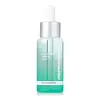What's inside
What's inside
 Key Ingredients
Key Ingredients

 Benefits
Benefits

 Concerns
Concerns

 Ingredients Side-by-side
Ingredients Side-by-side

Estriol 0.3%
Ascorbic Acid 1%
AntioxidantHyaluronic Acid 0.5%
HumectantAloe Barbadensis Leaf
MaskingGlycerin
HumectantSodium Bisulfate
BufferingBHT
AntioxidantAcrylates/C12-22 Alkyl Methacrylate Copolymer
Aluminum Starch Octenylsuccinate
AbsorbentBis-Vinyldimethicone/Bis-Isobutyl PPG-20 Crosspolymer
EmollientCaprylic/Capric Triglyceride
MaskingCarthamus Tinctorius Seed Oil
MaskingCeteth-20
CleansingCetyl Alcohol
EmollientCyclohexasiloxane
EmollientCyclopentasiloxane
EmollientDicaprylyl Ether
EmollientDimethicone
EmollientDimethyl Isosorbide
SolventDisteardimonium Hectorite
StabilisingGlyceryl Stearate
EmollientIsodecyl Neopentanoate
EmollientIsododecane
EmollientIsopropyl Palmitate
EmollientLaureth-12
EmulsifyingLecithin
EmollientOzokerite
Emulsion StabilisingPEG-75 Stearate
Petrolatum
EmollientPolysilicone-11
Potassium Sorbate
PreservativePropylene Carbonate
SolventSilica
AbrasiveSilica Silylate
EmollientSodium Lauryl Sulfoacetate
CleansingSorbic Acid
PreservativeSteareth-20
CleansingTitanium Dioxide
Cosmetic ColorantTriethoxycaprylylsilane
Estriol 0.3%, Ascorbic Acid 1%, Hyaluronic Acid 0.5%, Aloe Barbadensis Leaf, Glycerin, Sodium Bisulfate, BHT, Acrylates/C12-22 Alkyl Methacrylate Copolymer, Aluminum Starch Octenylsuccinate, Bis-Vinyldimethicone/Bis-Isobutyl PPG-20 Crosspolymer, Caprylic/Capric Triglyceride, Carthamus Tinctorius Seed Oil, Ceteth-20, Cetyl Alcohol, Cyclohexasiloxane, Cyclopentasiloxane, Dicaprylyl Ether, Dimethicone, Dimethyl Isosorbide, Disteardimonium Hectorite, Glyceryl Stearate, Isodecyl Neopentanoate, Isododecane, Isopropyl Palmitate, Laureth-12, Lecithin, Ozokerite, PEG-75 Stearate, Petrolatum, Polysilicone-11, Potassium Sorbate, Propylene Carbonate, Silica, Silica Silylate, Sodium Lauryl Sulfoacetate, Sorbic Acid, Steareth-20, Titanium Dioxide, Triethoxycaprylylsilane
Water
Skin ConditioningNiacinamide
SmoothingButylene Glycol
HumectantPEG-40 Hydrogenated Castor Oil
EmulsifyingSalicylic Acid
MaskingLentinus Edodes Mycelium Extract
Skin ConditioningGlyceryl Glucoside
HumectantSalvia Sclarea Oil
MaskingPhytic Acid
Terpineol
MaskingThymol
AntimicrobialCitrus Aurantium Dulcis Peel Oil
MaskingRosmarinus Officinalis Leaf Oil
MaskingLavandula Hybrida Oil
EmollientPelargonium Graveolens Flower Oil
MaskingLavandula Angustifolia Oil
MaskingCitrus Limon Peel
MaskingPolydextrose
HumectantGlycerin
HumectantDextrin
AbsorbentAmylopectin
Caprylyl Glycol
EmollientEthylhexylglycerin
Skin ConditioningXanthan Gum
EmulsifyingPentylene Glycol
Skin ConditioningSodium Hydroxide
BufferingIsoamyl Laurate
EmollientLimonene
PerfumingLinalool
PerfumingGeraniol
PerfumingCitronellol
PerfumingPhenoxyethanol
PreservativeWater, Niacinamide, Butylene Glycol, PEG-40 Hydrogenated Castor Oil, Salicylic Acid, Lentinus Edodes Mycelium Extract, Glyceryl Glucoside, Salvia Sclarea Oil, Phytic Acid, Terpineol, Thymol, Citrus Aurantium Dulcis Peel Oil, Rosmarinus Officinalis Leaf Oil, Lavandula Hybrida Oil, Pelargonium Graveolens Flower Oil, Lavandula Angustifolia Oil, Citrus Limon Peel, Polydextrose, Glycerin, Dextrin, Amylopectin, Caprylyl Glycol, Ethylhexylglycerin, Xanthan Gum, Pentylene Glycol, Sodium Hydroxide, Isoamyl Laurate, Limonene, Linalool, Geraniol, Citronellol, Phenoxyethanol
 Reviews
Reviews

Alternatives
Ingredients Explained
These ingredients are found in both products.
Ingredients higher up in an ingredient list are typically present in a larger amount.
Glycerin is already naturally found in your skin. It helps moisturize and protect your skin.
A study from 2016 found glycerin to be more effective as a humectant than AHAs and hyaluronic acid.
As a humectant, it helps the skin stay hydrated by pulling moisture to your skin. The low molecular weight of glycerin allows it to pull moisture into the deeper layers of your skin.
Hydrated skin improves your skin barrier; Your skin barrier helps protect against irritants and bacteria.
Glycerin has also been found to have antimicrobial and antiviral properties. Due to these properties, glycerin is often used in wound and burn treatments.
In cosmetics, glycerin is usually derived from plants such as soybean or palm. However, it can also be sourced from animals, such as tallow or animal fat.
This ingredient is organic, colorless, odorless, and non-toxic.
Glycerin is the name for this ingredient in American English. British English uses Glycerol/Glycerine.
Learn more about Glycerin